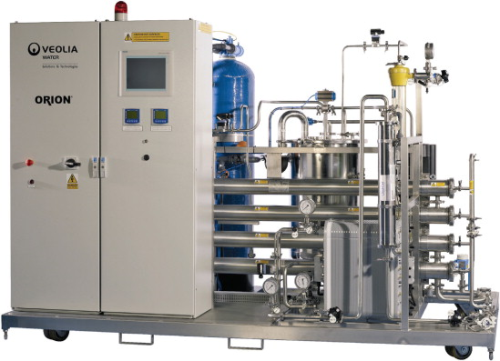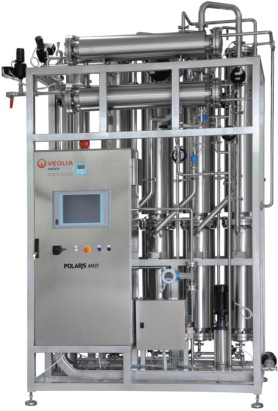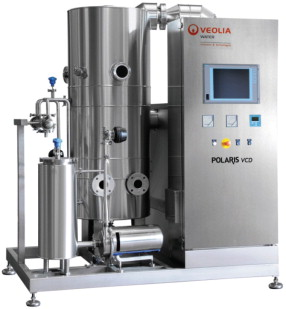


Pyrogens - what are they?
Pyrogens can be described as all substances that induce fever in humans or certain test animals within a limited effective period when applied parenterally in minute quantities. They can be regarded as relatively thermally stable and insensitive to pH changes.
The origin of pyrogenic substances varies and we can consider that organic molecules with a molecular weight of less than 1000 k dalton may have a pyrogenic effect. For instance, they may stem from viruses, certain organic compounds of non-biologic origin or certain protein components. The most important group of pyrogens in pharmaceutical production originates from the cell walls of gram-negative bacteria; these are also referred to as bacteria endotoxins.
The bacteria endotoxins represent lipopolysaccharide complexes with a high molecular weight.
Sources of contamination
There can be several sources of pyrogens in parenteral and medical device products. Usual sources include the water used as the solvent or in the processing and packaging components, as well as the chemicals, raw materials or equipment used in the preparation of the product. Good practice would include control of the microbiological and endotoxin levels of contamination in the potential sources.
For parenteral products, inspections have shown that where pyrogen problems were found in dosage forms, and when the source was one of the raw materials, it was the active drug substance. This was particularly true for drug substances in which process water was used at some later stage in the synthesis process. Endotoxin levels of the drug substance were subsequently lowered when the microbiological levels of the process water were lowered and the process water system was controlled.
As with most processes and pieces of equipment, it is good practice to know the limitations and/or capabilities of the equipment. For example, stills with high levels of endotoxins in the feed water have occasionally been shown to yield water-for-injection (WFI) of an unacceptable quality (>0.25 EU/ml). Some Pharmacopoeia allow the use of RO systems for WFI production. However, while it is true that RO membranes are able to perform a 3 log10 reduction of influent pyrogens, it is not possible to demonstrate that RO membranes can be classed as ‘sterile filters’. For this reason it is safer to produce WFI by distillation, where a phase passage does not allow bacteria to pass over. Whichever system is employed, good practice would include the ability to isolate and evaluate each piece of equipment in a WFI system.
Pyrogen-free water solutions
Veolia Water Solutions & Technologies has studied this related problem and has developed a new generation of water treatment systems able to produce purified water (PW), highly purified water (HPW) and water-for-injection (WFI).
PW and HPW are produced using a combination of reverse osmosis systems and continuous electrodeionisation (CEDI) equipment, such as ORION™.
ORION™ packaged systems are pre-validated, skid-mounted and hot water sanitisable. Developed specifically for the pharmaceutical market, they are compliant with the pharmaceutical industry requirements and have 80 standard options in order to best meet the unique needs of each client. Their nominal flow rates go from 500 to 10 000 l/hr.
Depending on the application, ORION™ can produce either USP/Ph Eur purified water or pyrogen-free (Ph Eur highly purified water). Their main features are:
• Guaranteed microbial compliance through regular hot water sanitisation at 85°C.
• Fast-track project delivery through truly standardised product.
• Designed, manufactured and validated to GAMP.
• Fully compliant with latest ISPE, USP and Ph Eur specifications.
• Reduced validation hours through standard validation package.
• Automated PLC control minimises operator involvement.
• Unique CEDI design efficiently and reliably ensures product quality.
WFI is produced with distillation systems like POLARIS MED and POLARIS VCD. The pharmaceutical distiller chemically and microbiologically purifies water by phase change and entrainment separation. In this process, water is evaporated producing steam. The steam disengages from the water leaving behind dissolved solids, non-volatiles, and high molecular weight impurities. However, low molecular weight impurities can be carried with water mist/droplets, which are entrained in steam. A separator removes fine mist and entrained impurities, including endotoxins. The purified steam is condensed into water for injection. Distillation systems are available to provide a minimum of 3 log10 reduction in contaminants such as microorganisms and endotoxins.
In a multi effect still, purified steam produced in each effect is used to heat water and generate more steam in each subsequent effect.
In a vapour compression still, steam generated by the evaporation of feed water is compressed and subsequently condensed to form distillate.
POLARIS is a standard packaged WFI system. They are the solution that fits biotechnology and pharmaceutical market expectations offering a major step forward in WFI generation systems by incorporating efficient design solutions and effective pyrogen removal.
POLARIS MED, multiple effect stills, use falling film technology to produce up to 10,000 l/h (with 3 bar industrial steam) of WFI from a PW feed. POLARIS uses an innovative separation system to ensure complete water droplet removal in each effect. Efficient droplet removal is a critical step in pyrogen removal. Since pyrogens are non-volatile they can only be carried by water droplets, once the feed water has been turned to steam. By effectively removing any entrained water droplets using a novel process based on differential kinetic energy, POLARIS provides good pyrogen removal security.
POLARIS VCD vapour compression stills are capable of producing up to 25,000 l/h of WFI from a softened mains water feed. They can be heated by steam or an electric immersion heater (depending on unit size), and an electrically powered vapour compressor provides the additional energy necessary to produce distilled water at a temperature between 25°C and 90°C depending on requirements.
POLARIS VCD is equipped with double tube sheet (DTS) heat exchangers for eliminating contamination risk between the feed water inlet and the water for injection, while optimising heat recovery from the outgoing WFI and also from the waste gases produced by the gas removal device. In POLARIS VCD, the contaminants are released from the vapour in the water droplet separator by close control of the shear and speed ratio between the vapour and any water droplets present.
References
Pharmaceutical Manufacturing revue, June 01-1991, Brandel Thimmel U.
M.P. Santoro and C.L. Maini, European Journal of Parenteral & Pharmaceutical Sciences, European Journal of Parenteral & Pharmaceutical Sciences 8 (March 2003).






